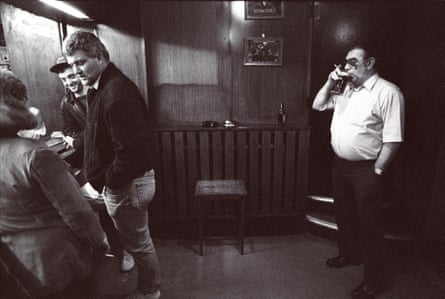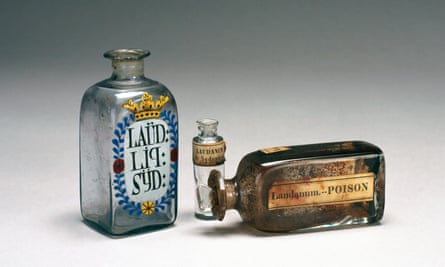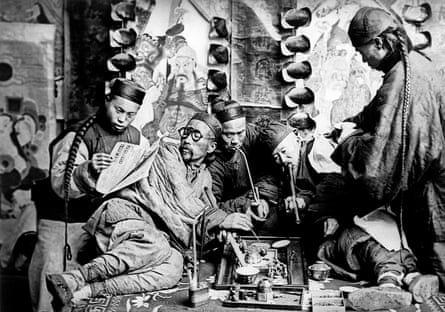Humans are an exquisitely intelligent and capable species of ape. Our physiology has been fine-tuned for efficient long-distance running; our hands are elegantly dextrous for manipulating and making; and our throats and mouths give us astonishing control over the sounds we make. We are virtuoso communicators, able to convey everything from physical instructions to abstract concepts, and to coordinate ourselves in teams and communities. We learn from each other, from our parents and peers, so new generations don’t have to start from scratch. But we’re also deeply flawed, physically and mentally. In many ways, humans just don’t work well.
We’re also riddled with defects in our biochemistry and DNA – data-corrupted genes that no longer work – which means, for instance, that we must eat a diet more varied than almost any other animal to obtain the nutrients we need to survive. And our brains, far from being perfectly rational thinking machines, are full of cognitive glitches and bugs. We’re also prone to addictions that drive compulsive behaviour, sometimes along self-destructive paths.
Many of our apparent faults are the result of evolutionary compromise. When a particular gene or anatomical structure is needed to satisfy several conflicting demands at the same time, no single function can be perfectly optimised. Our throats must be suitable not only for breathing and eating, but also for articulating speech. Our brains need to make survival decisions in complex, unpredictable environments, but they need to do so with incomplete information and, crucially, very rapidly. It is clear that evolution strives not for the perfect, but merely the good-enough.
What’s more, evolution is restricted, in finding solutions to new conditions and survival problems, to tinkering with what is already at its disposal. It never gets the chance to go back to the drawing board and redesign from scratch. We have emerged from our evolutionary history as a palimpsest of overlaying designs, with each new adaptation modifying, or being built on top of, what already existed. To be human is to be the sum total of all our capabilities and constraints – our flaws and our faculties make us who we are. And the story of human history has played out in the balance between them.
About 10 millennia ago, we learned to domesticate wild plants and animals to invent agriculture, and out of this grew increasingly complex social organisations: cities, civilisations, empires. And over this whole, staggering breadth of time, through growth and stagnation, progress and regression, cooperation and conflict, slavery and emancipation, trading and raiding, invasions and revolutions, plagues and wars – through all this tumult and fervour, there has been one constant: ourselves. In almost all key aspects of our physiology and psychology, we’re basically the same as our ancestors living in Africa 100,000 years ago. The fundamental aspects of what it means to be human haven’t changed.
Although we haven’t changed, our physical features, such as our five-fingered hands and our capacity for speech, have certainly left indelible marks on our world. Aspects of our psychology, too, have left their impression on human history and culture in profound and often surprising ways.
Many of these are so deeply ingrained in everyday life that we tend to overlook their biological roots. For example, we have a strong tendency towards herd behaviour – fitting in with those in our community by copying their decisions. In evolutionary terms, this has served us well. In a natural world full of dangers, it is probably safer to follow everyone else, even if you’re not convinced it’s the best course of action, rather than risk going it alone. Such herd behaviour is a way of crowdsourcing information – others may know something we don’t – and can serve as a quick judgment tool, allowing us to economise on the time and cognitive effort in deciding everything for ourselves.
Our herding bias has caused the surges of fads and fashions throughout history. It influences the adoption of other cultural norms, religious views or political preferences as well. But the same psychological bias also destabilises markets and financial systems. The dotcom boom of the late 1990s, for instance, was driven by investors piling in to back internet companies even though many of the startups were not financially sound. Investors followed one another, assuming that others had a more reliable assessment or simply not wanting to be left behind in the frenzy, only for the bubble to burst and stock markets to fall sharply after early 2000. Such speculative bubbles have recurred through history since “tulip mania” in the early 17th-century Netherlands, and the same herding behaviour is behind modern boom and bust cycles such as in cryptocurrency markets.
One of the most salient aspects of humanity is how, as an intelligent, self-aware species, we actively seek ways to alter our state of mind. We exploit the botanical world not only to feed ourselves, but to intentionally modify the functioning of our brain – to stimulate, to calm or to induce hallucinations. Indeed, enjoying getting out of our own minds is pretty much a universal of human cultures. The pursuit of money and power has found profitable ground in the human desire for altered states, and played a part in shaping human history.
Four substances in particular came to have widespread usage around the world: alcohol, caffeine, nicotine and opium. Each has been used widely as a recreational drug – that is, one taken socially or for pleasure rather than for medicinal purposes. While each of these have different effects on our central nervous system, they also all act to trigger a specific part of the brain.
The mesolimbic pathway runs forward from the brainstem and is made up of nerve cells that release the signalling molecule dopamine, which is enormously important in motivating our behaviour towards survival and reproduction. Eating food, quenching thirst or having sex all result in the release of dopamine and produce a reward signal in the brain – we perceive it as the sensation of pleasure.
In order to tune our behaviour to succeed in our natural habitat, our brain compels us to repeat the actions that activated the dopamine system last time and avoid those that previously suppressed it. Thus the neurochemical system of pleasure and reward is inextricably intertwined with that of learning.
This dopamine-mediated mechanism works exceedingly well at steering our behaviour towards the sort of actions that benefit us in the natural world. Problems arose, however, when humans discovered ways of triggering this reward-and-pleasure system with stimuli other than those associated with survival and reproduction – namely, drugs.

Alcohol, caffeine, nicotine and opium effectively short-circuit our brain’s reward system. They induce the release of dopamine in the mesolimbic pathway – or inhibit the removal of dopamine or make the receptors on the surface of neurones more sensitive – and in some cases they can produce pleasure, even euphoria, far more intense than anything encountered in the natural world. And unlike natural dopamine triggers, such as eating, they never result in satiation.
Such drugs create a false signal in the brain that indicates the arrival of a huge survival benefit, and the learning mechanism driven by this system prompts the brain to seek out repeated hits. This is the basis of addiction. We desire instant gratification without having to pay the costs associated with dopamine rewards in the natural world, such as spending time hunting for food.
With the rise of international trade, fermented beverages as well as distilled spirits, tea, coffee and tobacco became widely available around the world, and a huge fraction of humanity found ready access to psychoactive substances. While overconsumption of alcohol is the cause of societal problems, caffeine and nicotine generally produce only mild narcotic effects and an addiction no worse than the craving for a morning brew or drag on a cigarette (or more recently, a vape).
But in the 18th century the British demand for the stimulating effect of a cup of tea came to be supplied by the illicit trafficking of another psychoactive drug: opium. It is the story of how a mind-altering, addictive substance was used as a weapon by one empire to subdue another.
The demand for tea in Britain had grown steadily throughout the 18th century. By the 1790s, most of it came from China, with the East India Company shipping around 10,000 tonnes of tea leaves from east Asia to London every year. But there was one major problem: China had little interest in anything the British empire could offer in return. The Qianlong Emperor wrote to King George III in 1793, “Our Celestial Empire possesses all things in prolific abundance and lacks no product within its borders. There was therefore no need to import the manufactures of outside barbarians in exchange for our own produce.” Britain was facing a colossal trade deficit.
The only European commodity that China desired was hard cash in the form of silver. Throughout the second half of the 18th century, therefore, about 90% of Britain’s trade exports to China were bullion. The British government was struggling to raise enough silver to keep this trade going, and the East India Company was becoming concerned about maintaining its profits.
But then the agents of the East India Company realised they could create a growing market for something that they could source in bulk. While the Chinese government would only consider silver for official trade, the Chinese people were keen on something else: opium.

Opium is the latex fluid exuded from cuts made in the immature seed capsules of certain varieties of poppy, which is then dried to a powder. This latex contains the analgesic compound morphine (and also codeine), which provides pain relief and produces a warm feeling of relaxation and detachment. Poppies were cultivated for their opium in Mesopotamia by the Sumerians from the third millennium BC and named “plants of joy”. Opium use continued in the Middle East, as well as in Egypt, and the drug was known in ancient Greek medicine at least as early as the third century BC. By the eighth century AD, Arab traders had taken opium to India and China, and between the 10th and 13th centuries it made its way across Europe.
Taken orally, opium was used medically to treat pain. The morphine is able to bind to nerve cell receptors (which are normally targets for the body’s own hormones, such as endorphins) in parts of the brain involved in the sensation of pain, such as the thalamus, brainstem and spinal cord. But opiates also bind to receptors in the mesolimbic reward pathway, and so beyond its medicinal properties, opium was therefore craved as a recreational drug.
Opium was legal in Britain in the early 1800s, with British people consuming between 10 and 20 tonnes of the stuff every year. Powdered opium was dissolved in alcohol as a tincture called laudanum, which was freely available as a painkiller and even present in cough medicine for babies. Many late-18th and 19th-century literary figures were influenced by opium, including Lord Byron, Charles Dickens, Elizabeth Barrett Browning, John Keats and Samuel Taylor Coleridge. Thomas De Quincey found fame with his autobiographical Confessions of an English Opium-Eater. Drinking opium in this way produced mild narcotic effects but was also habit-forming – society at this time was therefore pervaded by high-functioning opium addicts, including many among the lower classes who were looking to numb the tedium of working and living in an industrialised urban world. But while laudanum helped inspire a few poets and fuelled bouts of aristocratic debauchery, drinking it delivered a relatively slow release of opiates into the bloodstream.
The Chinese, on the other hand, had taken to smoking opium. This delivers a much more rapid hit, which is consequently far more potent and addictive. The Chinese probably first came across opium smoking in the 17th century in the Dutch colonial outpost in Formosa (Taiwan); the Portuguese then began shipping the drug from their Indian trading hub in Goa to Guangzhou (then known as Canton) in the 18th century. So, although the East India Company didn’t create the initial demand for opium in China, they turbocharged it. They could bank on the key property of addictive substances: once you’ve gained a clientele for your product, you can be assured that your customers will keep coming back.
Instead of sending silver to China, the East India Company trafficked opium – and they could effectively grow as much of this new currency as they needed. Before long, the company was pushing the drug in amounts never seen before. Ultimately, it boiled down to one addiction being traded for another – caffeine for opium – but the British were forcing a far more destructive substance on the Chinese. In order for the English mind to be focused with tea, the Chinese mind was fogged with opium.
The East India Company had seized control of Bengal from the Mughal empire after the Battle of Plassey in 1757. It came to establish a monopoly on opium cultivation in the region and started running the drug into China. Opium consumption for non-medicinal uses was outlawed in China – the first laws banning opium had been enacted in 1729 – and so the East India Company couldn’t be seen to be illegally importing opium, as that would force a response from the emperor. Instead, it used independent “country firms” as middlemen – Indian merchants licensed by the company to trade with China. These firms sold the opium for silver in the Pearl River estuary, where it was then smuggled ashore.
This was a thinly veiled effort by the company to wash their hands of their formal involvement in the trafficking. As historian Michael Greenberg has put it, the East India Company “perfected the technique of growing opium in India and disowning it in China”. Meanwhile, a network of opium distribution spread through China, helped by corrupt officials who’d been paid off to look the other way.
The East India Company readily expanded its pipeline pumping opium into China until, in 1806, the tipping point was reached and the trade deficit had been forcibly reversed. The large numbers of Chinese opium addicts were now collectively paying so much to feed their habit that Britain was making more money from selling opium than it was spending on buying tea. The silver tide had been turned and the precious metal began flowing from China to Britain for the first time. The amount of opium imported into China by the East India Company trebled between 1810 and 1828, and then almost doubled again by 1832, to about 1,500 tonnes every year. The British empire, fuelled in the early days of its expansion across the Atlantic by one addictive plant, tobacco, was now wielding another, the poppy, as a tool of imperial subjugation.
We may never know for sure just how many Chinese men (it was mostly a male habit) were addicted to opium by the 1830s, but estimates at the time ranged between 4 and 12 million. Although opium did destroy the lives of those heavily addicted – transforming them into stupefied zombies when high, and at all other times listless and craving their next visit to the opium den – the drug remained relatively expensive and so largely limited in accessibility to the mandarin and merchant classes in China. Given the relatively small percentage of the population directly affected, the catastrophe for China was less the public health consequences than the economic disruption. As the silver paid to the British opium traffickers flowed out of China, the domestic supply diminished and the value of the precious metal rose. A farmer who had never touched an opium pipe now had to sell more of his crops to raise enough silver to be able to pay his taxes.

In 1839, the Daoguang Emperor declared a war on the drug and appointed a high-flying and moralistic bureaucrat, Lin Zexu, to stamp out the opium trade coursing through the coastal Guangzhou province, where the drug was landed by merchants at the port of Guangzhou itself. When he arrived at the foreign trading post in Guangzhou, Commissioner Lin ordered the British and other foreign merchants to immediately cease selling opium and hand over all the stock they had in the port’s warehouses to be destroyed. The traders refused, and in response Lin had the doors of the factories nailed shut and their food supply cut off.
The chief superintendent of trade for the British in China, Capt Charles Elliot, attempted to defuse the standoff. He was able to persuade the traders in Guangzhou to turn over a staggering 1,700 tonnes of opium from the port storehouses by promising that the British government would reimburse them for their losses. Lin disposed of the seized opium, which was hugely valuable, by having it mixed with water and lime in huge pits and then dumping the sludge into the Pearl River. The drugs bust was so large that it took three weeks to destroy it all. Commissioner Lin thought he was doing his honourable duty to stamp out the illegal smuggling of opium that was eating away at his countrymen; but the events that day would lead to a clash of empires and a humiliating defeat for China.
The deal struck by Elliot in Guangzhou seemed to have satisfied everyone: Lin successfully seized the drugs cache and destroyed the contraband; the traders accepted the offer of getting paid full price anyway; and Elliot kept the port open to British trade. Everyone, that is, apart from the prime minister, Lord Melbourne, who soon learned that the superintendent in Guangzhou had jauntily promised this huge payout on his behalf. The government now had to find £2m (equivalent to £164m today) to compensate the drug dealers. A local drugs bust had become an international incident, not just affecting merchants but challenging national pride. Lord Melbourne felt backed into a political corner, and believed he had no other choice but to use military action to force China to reimburse Britain for the destroyed goods.
The response was to become a common theme of European imperialism: gunboat diplomacy. A taskforce of around 4,000 British troops and 16 ships was dispatched to China, and the war lasted for three years, from 1839-42. Within the Royal Navy fleet was a new kind of ship, the Nemesis: a steam-powered warship made of iron, unmatched by anything the Chinese possessed. The British fleet blockaded the mouth of the Pearl River at Guangzhou and captured a number of ports including Shanghai and Nanjing. On land, Chinese armies were torn apart by British rifles and military training. China had invented gunpowder and the blastfurnace, but now a European imperial power was arriving on its shores turning these innovations against it.
In July 1842, British ships and troops effectively closed off the Grand Canal, a crucial artery distributing grain throughout China. Beijing was threatened with famine, and the Daoguang Emperor was forced to sue for peace. The treaty of Nanjing was humiliating. China was forced to pay huge reparations for the confiscated opium and subsequent conflict, cede Hong Kong (the “fragrant harbour”) to the British as a colony and open five “treaty ports”, including Canton (Guangzhou) and Shanghai, to British merchants and other international trade. But the British were still not satisfied, leading, in 1856, to the second opium war, and the greater opening of China to foreign merchants as well as the full legalisation of the opium trade.
Recreational opium use expanded across China, extending from the urban elites and middle class to rural workers. By the time Japan invaded China in 1937, 10% of the population – 40 million people – were believed to be addicted to opium. It was not until after the communist takeover in 1949 and the arrival of the totalitarian regime of Chairman Mao that rampant opium addiction was finally stamped out in China.
China endured an opioid crisis lasting around 150 years, forced upon it by corporate greed and imperial coercion. Today, more than 250,000 hectares of land are used for opium poppy cultivation, the vast majority of it grown illicitly in Afghanistan. In a recent survey, about 10 million people in the US self-reported the non-medical use of opioids, although this figure is likely to be an underestimate (the survey data does not include the homeless or institutionalised populations, for instance). However, more than 90% of this opioid consumption is not heroin, but legally produced, painkilling pharmaceuticals misused by those who have become addicted to such medication.

This current opioid epidemic, echoing that in 19th century China, has its roots in the 1990s, when drug companies, including Purdue Pharma, looking to increase the prescription of opioid drugs, and thus their profits, convinced the regulators and medical community in the US that their synthetic opioid pills were not addictive. Patients were prescribed ever-higher opioid doses as they built up a tolerance, until many developed a dependence and became reliant on the drug to avoid nasty withdrawal symptoms. Millions of addicts continued to seek opioids on the hidden market, and between 1999 and 2020, more than half a million died from an opioid overdose. The US Department of Health and Human Services declared a nationwide public health emergency in 2017, and steps are being taken to control the opioid crisis, but overdose deaths from synthetic opioids such as tramadol and fentanyl continue to rise.
Our brain’s system for governing reward and learning evolved to modify our behaviour for survival in our natural habitat, but is vulnerable to being hacked by psychoactive substances. Throughout history, humans have actively sought out recreational drugs that deliver a pleasurable rush, but as a consequence are intrinsically addictive. Through this fundamental aspect of our biology, substances that we consume to modify our mental state also came to change the world.
This is an edited extract from Being Human: How Our Biology Shaped World History published by Bodley Head and available at guardianbookshop.com
This article was amended on 23 May 2023. An earlier version said that the first opium war lasted for three years, from 1939-42, instead of 1839-42.